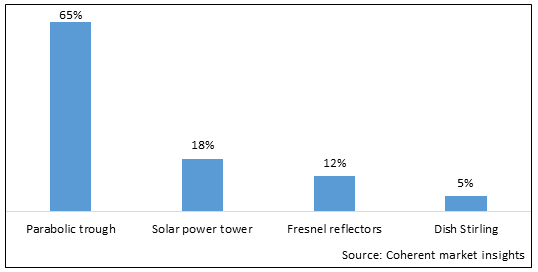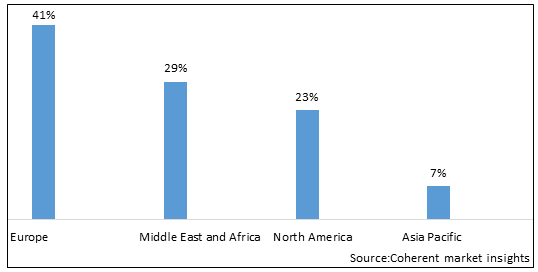Concentrated Solar Power Market is estimated to be valued at USD 7.19 Bn in 2025 and is expected to reach USD 14.74 Bn in 2032, exhibiting a compound annual growth rate (CAGR) of 10.8% from 2025 to 2032. The global concentrated solar power (CSP) market is predicted to grow rapidly as more heat storage systems are installed and concentrated solar power facilities are hybridized with traditional thermal plants. Factors such as increased global warming awareness and rising greenhouse gas emissions are pushing the total market for CSP. Furthermore, rising traditional energy prices and growing concerns about energy availability in the future are projected to fuel the growth of the concentrated solar power market.
Global Concentrated Solar Power Market Drivers
The International Energy Agency predicts that over the next few years, a greater proportion of Renewable energy will be used to meet the world's energy needs. Renewable energy comes from organic sources like the sun's rays and the wind. Some of the main renewable energy sources include solar, geothermal, wind, bioenergy, hydropower, and ocean power. Currently, heating, electricity, cooling, and transportation all use renewable energy. A number of factors have increased the use of renewable energy sources, with the most important one being the link between carbon dioxide (CO2) emissions from the burning of fossil fuels and global warming. Concentered solar thermal market demand is anticipated to be driven by rising concerns about greenhouse gas emissions and a growing need for energy security during the forecast period.
In many nations, renewable energy is encouraged as a potential major new source of employment and rural development as well as a way to address environmental and energy security issues. The development of renewable energy has received enormous public funding from many governments, and these governments now demand that energy providers sell significant amounts of renewable energy. Indeed, solar energy represents a chance to boost local economies in hosting areas. It also needs a long-term strategy and a complex, adaptable policy framework.
Solar energy is one of the most plentiful sources of renewable energy in the majority of the Asia-Pacific region. Because of this, a number of nations in this region have medium- to long-term policies to support the expansion of solar and other resources in their overall energy portfolio.
As a result of capacity targets set forth in the nation's 13th five-year plan for 2020 and concerns about air pollution, China alone is responsible for more than 40% of the growth of the world's renewable capacity. China has actually already surpassed its 2020 solar PV target and is anticipated to surpass its 2019 wind target. In addition, China dominates the global markets for electric vehicles, bioenergy for electricity and heat, and hydropower.
Developing countries, such as India, are witnessing rapid growth in peak electricity demand, and therefore, local governments and the electricity utilities are coming up with plans such as “Development of Solar Cities” to encourage local bodies to come up with road map to guide their cities in becoming “renewable energy cities” or “solar cities.” Thus, the aforementioned factors are predicted to have a positive impact on the market growth.
Global Concentrated Solar Power Market Opportunities
The Feed-in Tariff (FIT) scheme allows homes, communities, company owners, and private developers to generate renewable energy and sell it to the province at a fixed contract price for a set period of time. The FIT price is the amount paid per kWh of power delivered to the provincial grid under a FIT contract. The cost of producing power varies depending on the renewable energy technology employed and the size of the project. Feed-in Tariff schemes were developed in countries such as Canada and the United States in 2009 to encourage the development of renewable energy technology and attract investments to lessen the increased reliance on fossil fuels through means of phasing out coal-fired plants. As a result, the continued expenditures and dedication to development as growth.
In recent years, there has been a shift toward the usage of localized energy purchase. Various government organizations in countries such as India have used community choice aggregation (CCA) policies to acquire renewable energy resources on behalf of their people while retaining their existing power provider for transmission and distribution services.
Global Concentrated Solar Power Market Trends
The key trend observed in the global concentrated solar power (CSP) market is the market for global concentrated solar power (CSP) market rising R&D activities. The Office of Energy Efficiency and Renewable Energy recently allocated $9.0 million for 6 research and development projects in the CSP market. This is probably going to lead to improvements in technology and lower costs in the CSP market, which will open up lots of opportunities during the forecast period.
Concentrated Solar Power Market Report Coverage
| Report Coverage | Details | ||
|---|---|---|---|
| Base Year: | 2024 | Market Size in 2025: | USD 7.19 Bn |
| Historical Data for: | 2020 To 2024 | Forecast Period: | 2025 To 2032 |
| Forecast Period 2025 to 2032 CAGR: | 10.8% | 2032 Value Projection: | USD 14.74 Bn |
| Geographies covered: |
|
||
| Segments covered: |
|
||
| Companies covered: |
Siemens AG, Genarl Electric, Abengoa, Acciona S.A., Atlantica Yield plc., Suntrace GmbH, BrightSource Energy, Inc., SolarReserve, LLC., ACWA Power, Frenell GmbH |
||
| Growth Drivers: |
|
||
| Restraints & Challenges: |
|
||
Uncover macros and micros vetted on 75+ parameters: Get instant access to report
Global Concentrated Solar Power Market Restraints
Infrastructure development for the development of new renewable resources requires sizable upfront investments. These expenditures raise the price of supplying renewable electricity, particularly in the beginning. The first step for the developers is to identify sites that are acceptable to the public, have good resources, and have access to transmission lines. Finding a potential solar site and evaluating its suitability takes several years of observation. Additionally, workers must receive training on how to install, use, and maintain the new technologies. Before their performance can be optimized, some renewable energy sources need to have operating experiences in specific climatic conditions. During the forecast period, all of these factors are expected to impede the growth of the global market for concentrated solar power.
BY TECHNOLOGY
Parabolic trough
Solar energy is focused onto a receiver pipe using parabolic curved trough-shaped reflectors in the parabolic trough technology. The receiver pipe is shaped to follow the parabolic trough's curved surface. Increased from 293oC to 393oC is the temperature of the transfer fluid used in the parabolic trough. In a typical steam generator, the thermal oil is used as the transfer fluid, and the heat energy is then used to produce electricity. The employed collector has a trough in the adjacent row. As a result, during the day, the axis of the troughs can follow the sun as it moves from east to west. The sun is continuously focused on the receiver pipes thanks to this configuration.
Solar Power Tower
Heliostats, also known as tracking reflectors, make up the Solar Power Tower. These heliostats aid in concentrating the sun's rays on the tower's central receiver. Heat-transfer fluid, such as water-steam or molten salt, makes up the solar power tower receiver end. A heat source for power generation or an energy storage system is created by heating the working fluid in the solar power tower receiver to temperatures between 500 and 1000 °C. A circular Fresnel reflector is similar to how the Solar Power Tower operates.
Figure 1. Global concentrated solar power market by Technology in 2025

To learn more about this report, Download Free Sample
BY END-USER INDUSTRY
Residential
The heat produced by CSP's exhaust can be used to warm water. For use in facilities like dorms or hospitals, the water can be heated for domestic or institutional use. These utilize hot water for various purposes, such as cleaning, bathing, cooking, and more. One of the most crucial uses is for heating water, and the savings are simple to calculate. Additionally, CSP's free heat energy can be used for space heating in buildings like factories, hospitals, dorms, and homes. However, the same heat can provide cooling when absorption chillers are used.
Commercial
More and more commercial uses for CSP's exhaust heat are emerging. For more than 20 years, utility-scale solar facilities have been producing significant amounts of dependable and clean energy at a stable price. Multiple solar technologies, including concentrating solar power (CSP), photovoltaics (PV), and concentrating photovoltaics (CPV), are used in a utility-scale solar power plant. Utility-scale solar facilities now have built-in storage capabilities, much like traditional power plants do, to provide power when there is no sunlight, thanks to advancements in technology and innovation. The demand for CSP is increased as a result of the rising energy needs of developing nations and the high growth potential of utility-scale solar facilities.
REGIONAL INSIGHTS
Based on geography, the global concentrated solar power market is segmented into Europe, Asia Pacific, Middle East & Africa, Latin America, and North America
At present, Europe is a prominent generator and consumer of global Concentrated Solar Power market. Because the application industries using this technology have grown reasonably well. The main driver of new CSP applications is ongoing technological advancements brought on by significant investments in R&D, which in turn helps the North American CSP market grow. Residential, commercial, and industrial end-user segments are linked to numerous innovations and significant growth potential. To meet the rising demand for CSP technology in North America, businesses have employed strategies like product launch and expansion.
At the same time, Middle East and Africa global Concentrated Solar Power market. By 2030, the total CSP capacity within the European Union is anticipated to increase to 5 GW. Pilot-scale CSP projects are still being built in Europe, with a 9 MW Fresnel facility being built in France and a hybrid biomass-CSP facility with 17 MW of CSP being built in Denmark.
Figure 2. Global Concentrated Solar Power Market by region in 2025

To learn more about this report, Download Free Sample
Key Developments
Key Companies Insights
Siemens AG, Genarl Electric, Abengoa, Acciona S.A., Atlantica Yield plc., Suntrace GmbH, BrightSource Energy, Inc., SolarReserve, LLC., ACWA Power, Frenell GmbH
*Definition: Mirrors are used in CSP technologies to reflect and concentrate sunlight onto a receiver. The concentrated sunlight's energy heats a high-temperature fluid in the receiver. This heat, also known as thermal energy, can be used to spin a turbine or power an engine, so producing electricity.
Share
Share
About Author
Yash Doshi is a Senior Management Consultant. He has 12+ years of experience in conducting research and handling consulting projects across verticals in APAC, EMEA, and the Americas.
He brings strong acumen in helping chemical companies navigate complex challenges and identify growth opportunities. He has deep expertise across the chemicals value chain, including commodity, specialty and fine chemicals, plastics and polymers, and petrochemicals. Yash is a sought-after speaker at industry conferences and contributes to various publications on topics related commodity, specialty and fine chemicals, plastics and polymers, and petrochemicals.
Missing comfort of reading report in your local language? Find your preferred language :
Transform your Strategy with Exclusive Trending Reports :
Frequently Asked Questions
Select a License Type
Joining thousands of companies around the world committed to making the Excellent Business Solutions.
View All Our Clients